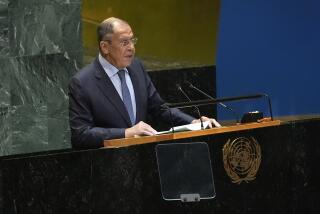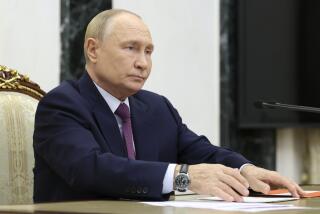Soviets’ Shift on Arms Brings Mixed Prospects
- Share via
HELSINKI, Finland — As Secretary of State George P. Shultz prepared to arrive in Moscow todayfor arms control talks, there was a growing consensus among experts on the Soviet Union that the Kremlin has significantly changed its attitude toward arms issues under leader Mikhail S. Gorbachev in a way that enhances prospects for agreements in the long run.
But in the short run, negotiations toward such agreements could require re-examination of fundamental North Atlantic Treaty Organization doctrine and spark fights within the alliance, particularly if some types of nuclear weapons are to be eliminated, rather than just reduced in number.
For example, while one goal of Shultz’s meetings in Moscow is an accord to reduce to zero the number of longer-range intermediate nuclear missiles in Europe, the possibility of eliminating the shorter-range missiles as well is far from being warmly or universally embraced by the Europeans. The longer-range weapons have a range of 1,000 to 3,000 miles and the shorter category extends from 350 to 1,000 miles. Both are lumped together under the designation intermediate nuclear forces.
Soviets May Propose
A senior Administration official noted Sunday that the Soviets this week may propose eliminating both categories of weapons. “But whether we are prepared to go to that, whether our allies would want to go to that, is not certain by any means,” he cautioned.
Eliminating all such weapons would have to be considered within the context of NATO’s doctrine of “flexible response,” the official explained. Under the doctrine, NATO needs many types of nuclear weapons to provide many graduated options for replying to a Soviet conventional or nuclear attack, short of all-out nuclear war.
How many of the shorter-range missiles are needed to satisfy the doctrine, in a Europe that might be free of the longer-range weapons, has yet to be worked out, the official said. The issue illustrates some of the problems created by the new approach of Gorbachev during his two years in office.
Whether today’s more forthcoming stand by the Kremlin on security issues represents the view of Gorbachev, a young leader with a fresh approach, or whether it has been forced on the Kremlin by America’s military buildup over the past seven or eight years is not clear to Soviet specialists. Nor do all of these experts accept the apparent change as sincere. A minority sees it as a propaganda ploy to lull the West.
Nonetheless, in the words of a recent Rand Corp. report on a conference of Soviet specialists, a majority believes that Gorbachev and his team have “introduced striking innovations in Soviet arms control behavior” and signaled “a shift in traditional Soviet arms control objectives.”
Forced to Choose
During previous strategic arms negotiations, for example, when the Soviets were forced to choose between limiting U.S. forces or allowing their own weapons programs to go forward, they almost invariably chose to protect their own programs. But now, the two most dramatic features of Gorbachev’s new proposal “go precisely in the opposite direction,” the Rand report said.
These are radical cuts of 50% in offensive intercontinental nuclear weapons and elimination of all the longer-range intermediate missiles from Europe.
Both have been longstanding U.S. goals in the arms talks.
Along the same line, but somewhat less tangible, Kremlin leaders in the past always spoke of the Soviet need for “equal security.” This was translated to mean that Soviet forces had to be equal to the combined forces of all potential enemies, such as the United States and China, at the same time. If achieved, this would mean that the Soviet forces would be greater than those of any individual potential enemy, such as the United States.
Gorbachev now speaks instead of the Soviet goal of “common security,” which emphasizes the balance between the two superpowers, with their massive nuclear arsenals, in maintaining world peace. Some experts believe that under this concept, Gorbachev hopes to reduce the number of nuclear weapons produced for the Soviet military in the next decade.
Gorbachev has moved in other ways as well to change previous patterns.
Civilians seem to have a greater voice in determining security policies now, and most members of the Politburo’s Defense Council--the Soviet counterpart to the U.S. National Security Council--have been replaced in the past two years.
In addition, four of the five top military service chiefs have been retired, and the defense minister does not sit as a full member of the Politburo as he did in the past.
All told, these moves appear to represent a significant break with past Soviet military and arms control policies, the Rand report said, and suggest that Gorbachev views the trade-offs involved in arms negotiations differently from his predecessors.
But it is unclear whether this is a real and permanent change in Soviet policy and, if so, whether the United States and its allies can convert the change into new arms agreements beneficial to both sides.
More to Read
Sign up for Essential California
The most important California stories and recommendations in your inbox every morning.
You may occasionally receive promotional content from the Los Angeles Times.









